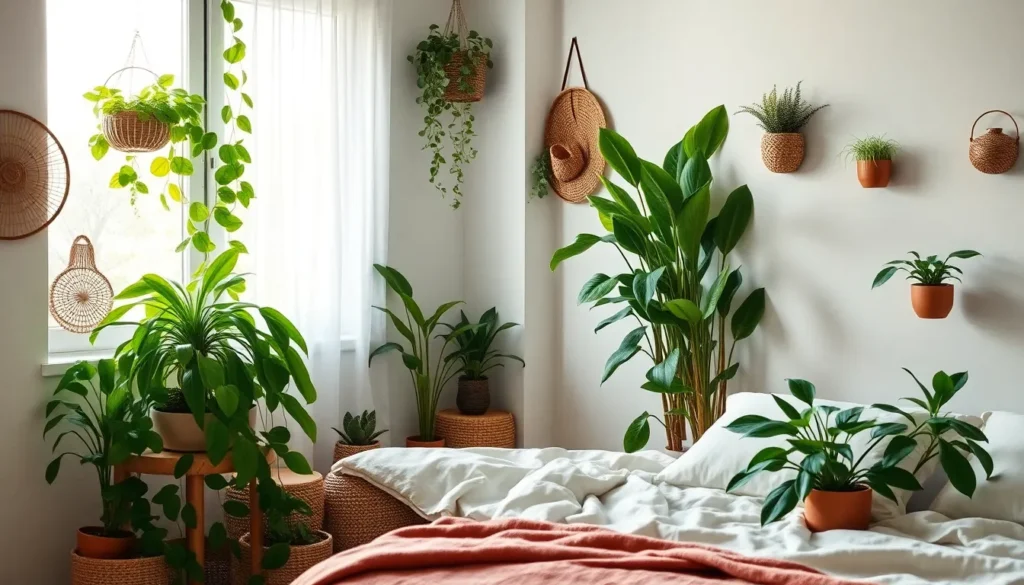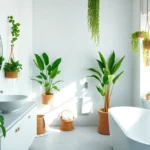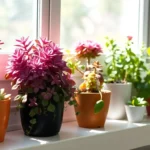We’ve all experienced that moment when we walk into our bedroom and feel like something’s missing. The space feels sterile even though our best decorating efforts. That’s where the magic of plants comes in – they’re nature’s perfect bedroom accessory that transforms any sleeping space into a serene sanctuary.
Plants aren’t just beautiful decorations; they’re powerful air purifiers that actively improve our sleep quality. While we rest they work tirelessly to filter toxins and release fresh oxygen creating the ideal environment for deeper more restorative sleep. From cascading pothos that add dramatic flair to compact snake plants that thrive in low light there’s a perfect green companion for every bedroom style.
The best part? You don’t need a green thumb to create a stunning plant-filled bedroom oasis. We’ll show you exactly how to choose maintain and style the perfect plants that’ll turn your bedroom into the peaceful retreat you’ve always dreamed of.
Choose Low-Light Plants Perfect for Bedroom Environments
Bedrooms typically receive less natural light than other rooms in our homes, making plant selection crucial for successful bedroom decor. We’ve identified the best low-light champions that thrive in these cozy, dimmer spaces.
Snake Plants for Minimal Maintenance
Snake plants (Sansevieria trifasciata) excel in bedroom environments with their remarkable tolerance for low light conditions. We recommend these sculptural beauties because they require watering only every 2-3 weeks and can survive in almost any lighting situation. Their upright, sword-like leaves add architectural interest to bedroom corners while releasing oxygen at night, unlike most plants that only produce oxygen during daylight hours.
Place your snake plant in a decorative ceramic pot near your dresser or nightstand for maximum visual impact. We’ve found that varieties like ‘Laurentii’ with yellow-edged leaves or ‘Moonshine’ with silvery-green foliage complement modern bedroom aesthetics perfectly.
Pothos Varieties for Trailing Beauty
Pothos plants create stunning cascading displays that soften bedroom spaces with their heart-shaped leaves. We love how golden pothos (Epipremnum aureum) trails gracefully from hanging planters or high shelves, adding natural movement to static bedroom decor. These versatile plants adapt to low light conditions while maintaining their vibrant variegation.
Consider marble queen pothos for bedrooms with predominantly white or neutral color schemes, as their cream and green marbling echoes sophisticated decor themes. Neon pothos varieties bring unexpected pops of chartreuse color that complement both minimalist and maximalist bedroom styles.
ZZ Plants for Dark Corners
ZZ plants (Zamioculcas zamiifolia) transform the darkest bedroom corners into lush green focal points. We appreciate their glossy, waxy leaves that reflect available light, making small bedrooms appear brighter and more spacious. These plants tolerate extreme low light conditions and can go 3-4 weeks without water, making them perfect for busy lifestyles.
Position your ZZ plant in a tall floor planter beside armchairs or in unused corners where other plants would struggle to survive. We’ve successfully grown ZZ plants in bedrooms with only north-facing windows, proving their exceptional adaptability to challenging light conditions.
Select the Right Plant Containers to Match Your Bedroom Style
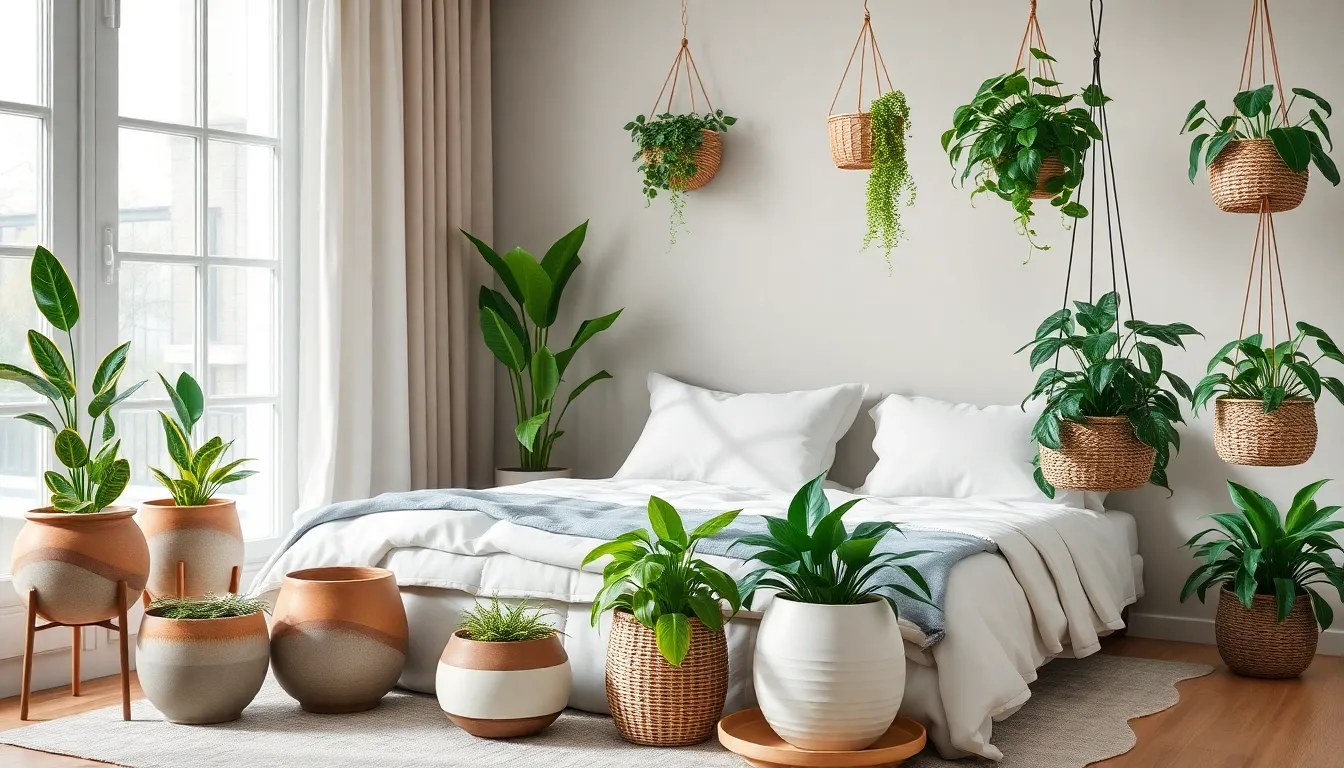
Choosing the perfect containers transforms your bedroom plants from simple greenery into stunning design elements. We’ll explore three container styles that enhance different bedroom aesthetics while supporting your plants’ health and growth.
Ceramic Pots for Modern Aesthetics
Ceramic pots elevate modern bedroom designs with their clean lines and smooth finishes. These containers complement minimalist decor through their wide range of colors and patterns, from neutral tones like white, gray, and black to vibrant accent hues. We recommend ceramic pots for supporting snake plants or ZZ plants, which thrive in bedroom environments with low to indirect light. Their solid structure provides excellent stability while their polished appearance adds a sophisticated touch to sleek contemporary spaces. Modern bedrooms benefit from ceramic containers because they create visual cohesion with other streamlined furnishings and maintain the uncluttered aesthetic that defines this style.
Woven Baskets for Bohemian Vibes
Woven baskets perfectly capture the free spirited essence of bohemian bedroom styles. Natural textures and earthy tones from these containers bring warmth and create a cozy, relaxed atmosphere. We suggest pairing woven baskets with trailing plants such as philodendrons or Sweetheart Vine, whose cascading foliage beautifully complements the soft materials. Bohemian bedrooms come alive when you use hanging baskets or place woven pots on shelves and floors throughout the space. These containers enhance the room’s eclectic aesthetic while maintaining the natural, inviting vibe that makes boho style so appealing.
Hanging Planters for Space-Saving Answers
Hanging planters maximize your bedroom’s greenery potential without sacrificing valuable floor or surface space. These versatile containers use vertical space effectively, making them excellent for incorporating plants like pothos or bromeliads in compact bedrooms. We appreciate hanging planters because they come in various materials from ceramic to macramé woven holders, suiting modern, bohemian, or industrial styles seamlessly. Space conscious bedrooms benefit tremendously when you position hanging containers near windows or above furniture, creating visual interest at different heights. These planters keep bedside tables and floors clear while adding dramatic cascading elements that draw the eye upward and make rooms feel larger.
Position Plants Strategically for Maximum Visual Impact
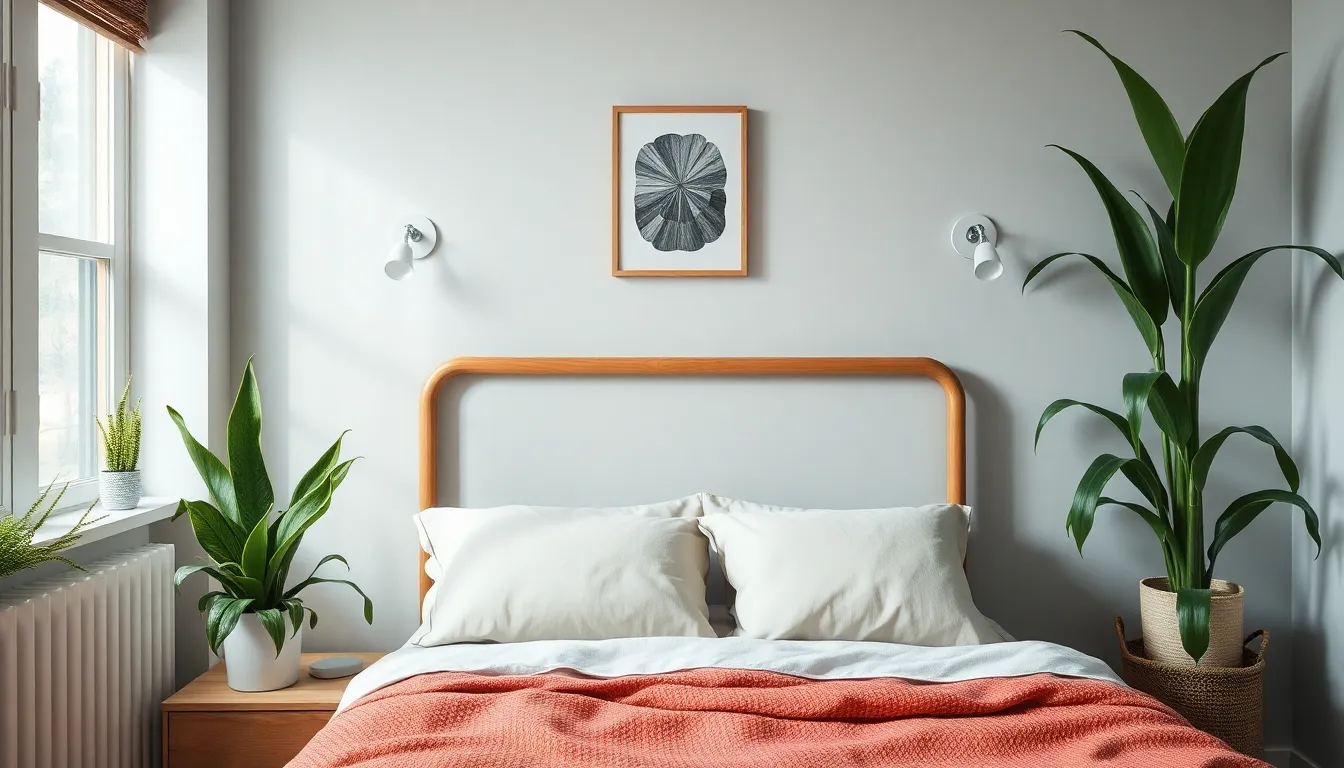
Now that we’ve covered container selection, let’s focus on where to place your plants for the most stunning bedroom transformation. Strategic positioning makes the difference between scattered greenery and a cohesive, visually striking plant arrangement.
Nightstand Plants for Bedside Appeal
Bedside tables offer the perfect opportunity to create a calming atmosphere right where you wake up and wind down each day. Small potted plants on nightstands add a refreshing touch to your sleeping area while keeping greenery within easy reach for daily care.
Choose low-maintenance plants that thrive in varying light conditions. Snake plants work exceptionally well on bedside tables because they tolerate low light and require minimal watering. ZZ plants also excel in this placement, handling the different light levels that occur on either side of your bed throughout the day.
Position plants so they’re easily visible from your bed without crowding your nightstand essentials. We recommend placing one small plant per nightstand to maintain balance and functionality. This creates a symmetrical look while ensuring you still have space for your lamp, books, and other bedside necessities.
Floor Plants for Corner Statement Pieces
Corners of bedrooms are ideal spots for larger floor plants that serve as dramatic statement pieces. These empty spaces naturally call for vertical interest, and tall plants fill this need while adding natural texture and color to otherwise unused areas.
Corn plants and other tall leafy varieties work exceptionally well as corner statement pieces. These plants add height without overwhelming the room’s proportions. Their substantial presence creates a focal point that anchors the space visually while drawing the eye upward.
Mix tall and short plants in corners to create lush “plant havens” that feel intentional rather than random. We suggest pairing one large floor plant with smaller companions at its base. This layered approach creates depth and visual interest while maximizing the impact of your corner display.
Wall-Mounted Options for Vertical Interest
Wall-mounted planters and plant walls create bold, unique displays that maximize your bedroom’s vertical space. This approach draws the eye upward, improving the perceived height of your room while freeing up valuable floor space for other furniture.
Create a living art piece with climbing or vining plants supported by wall-mounted trellises. A wall of greenery transforms an ordinary bedroom wall into a striking focal point. Plants like pothos cascade beautifully from wall planters, creating natural artwork that changes and grows over time.
Consider high-quality artificial plants or moss walls if you prefer lower maintenance options. These alternatives still provide the visual impact of greenery without requiring daily care or exact lighting conditions. Wall-mounted artificial options work particularly well in areas with limited natural light where live plants might struggle.
Create Air-Purifying Benefits While You Sleep
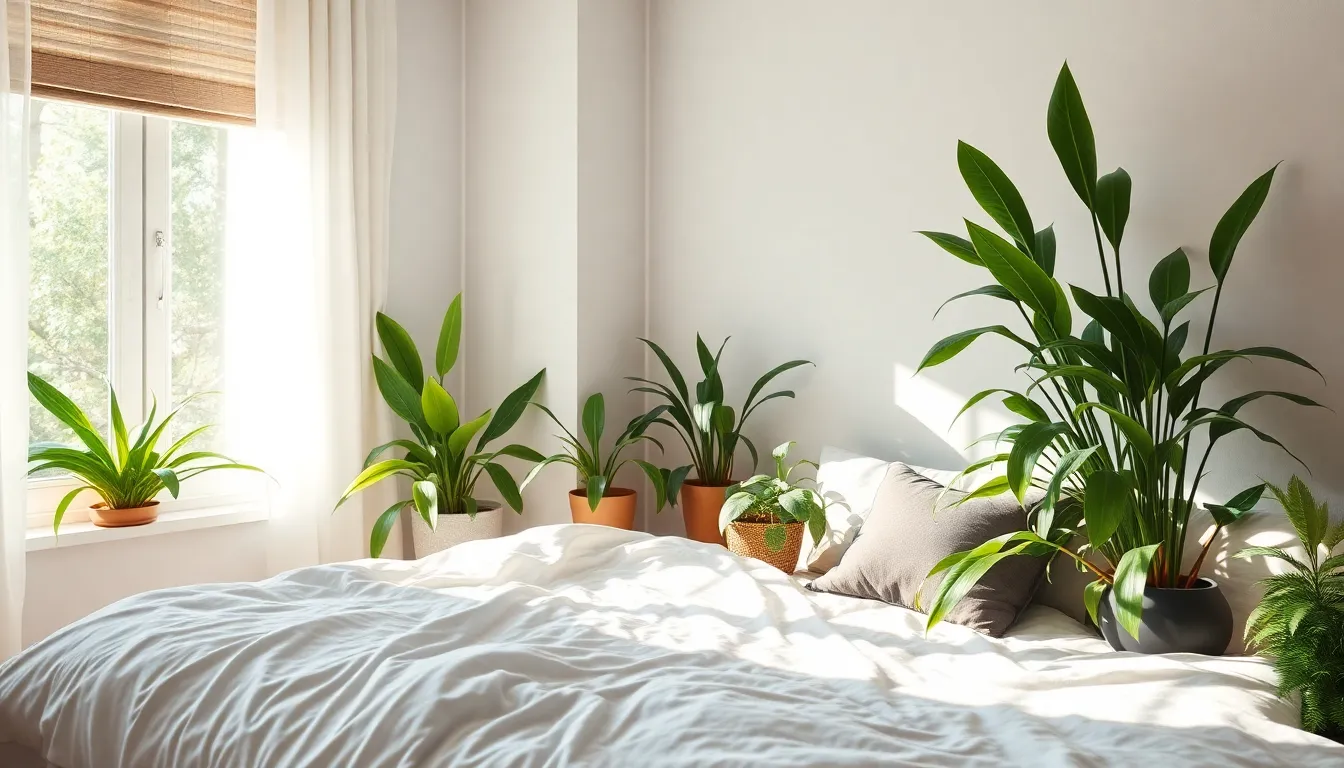
Transform your bedroom into a natural health sanctuary with strategically chosen plants that work around the clock to cleanse your air. While you rest, these green allies actively filter harmful toxins and boost oxygen levels for deeper, more restorative sleep.
Best Oxygen-Producing Plants for Nighttime
Most plants pause their oxygen production after sunset, but snake plants continue converting carbon dioxide into fresh oxygen throughout the night. We recommend placing a Sansevieria near your bed to maximize this unique nighttime benefit that supports better breathing while you sleep.
English ivy offers another excellent option for continuous air improvement, releasing oxygen even in low-light bedroom conditions. Golden pothos plants complement this effect by maintaining steady oxygen output during evening hours when other houseplants typically reduce their activity.
Spider plants round out our top nighttime oxygen producers, working efficiently in bedroom environments with minimal light requirements. These plants create a natural air circulation system that keeps your sleeping space fresh and oxygen rich throughout the night.
Plants That Remove Common Bedroom Toxins
Spider plants excel at filtering out formaldehyde, xylene, and toluene from bedroom air, making them perfect for spaces with synthetic carpets or furniture. We’ve found these versatile plants particularly effective in bedrooms where off-gassing from mattresses and bedding materials can accumulate overnight.
Heartleaf philodendrons specialize in removing formaldehyde, a common toxin found in bedroom fabrics and pressed wood furniture. These plants work continuously to absorb these harmful chemicals that can disrupt sleep quality and cause respiratory irritation.
English ivy and golden pothos serve as powerful air purification partners, targeting multiple toxins simultaneously throughout your sleeping hours. Bird’s nest ferns add both toxin removal capabilities and natural humidity control, creating the ideal bedroom atmosphere for restful sleep.
Humidity-Regulating Plant Options
Bird’s nest ferns naturally release water vapor through transpiration, maintaining optimal bedroom humidity levels that prevent dry air discomfort. We recommend these tropical plants for bedrooms where heating systems or air conditioning create overly dry conditions that can irritate skin and respiratory passages.
Balanced humidity from bedroom plants discourages mold growth and reduces allergens that commonly accumulate in sleeping spaces. Spider plants and English ivy contribute to this humidity regulation while simultaneously purifying your bedroom air for maximum health benefits.
Proper humidity levels from plant transpiration improve respiratory comfort and support natural skin hydration throughout the night. These moisture-regulating plants create a more comfortable sleeping environment while working continuously to filter toxins from your bedroom air.
Style Different Bedroom Themes with Plant Arrangements
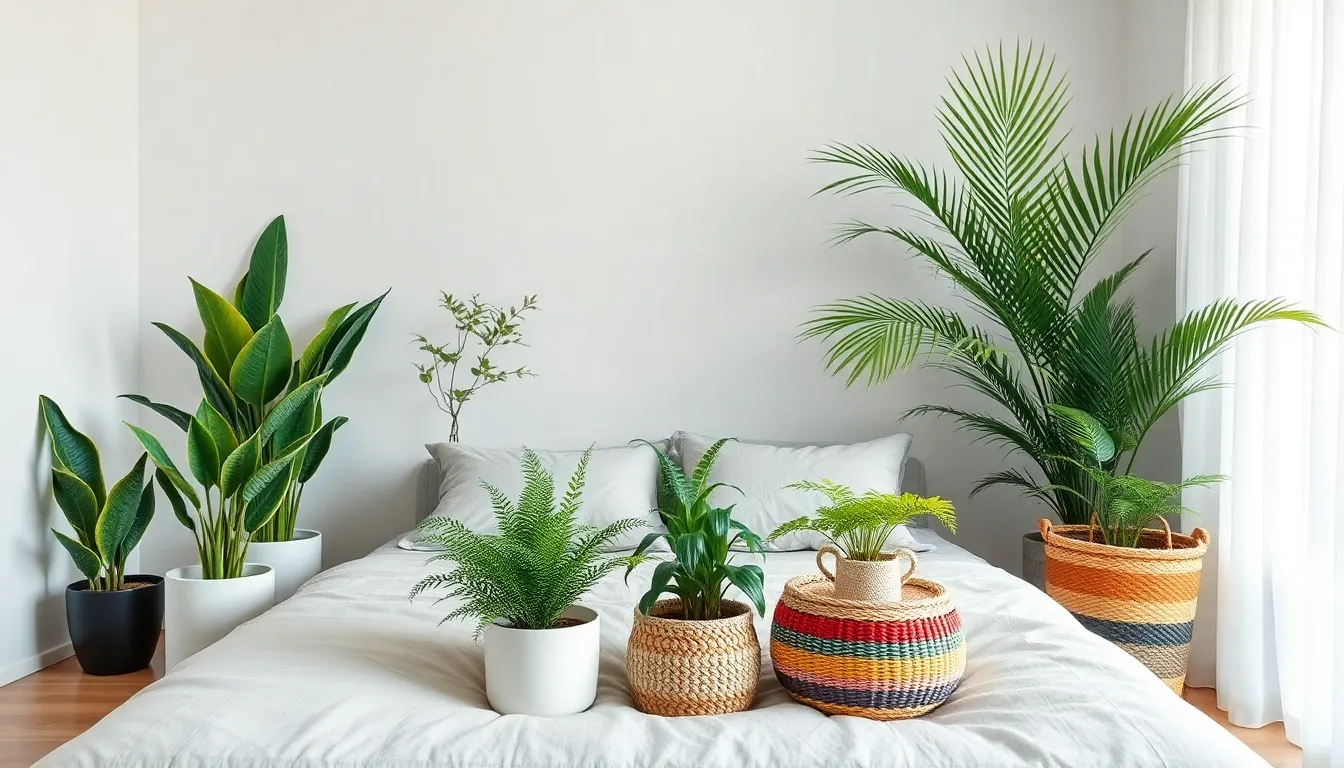
We’ll transform your bedroom into a stunning sanctuary by matching plants to your preferred design aesthetic. Different themes require unique plant selections and styling approaches to achieve the perfect look.
Minimalist Bedroom Decor with Plants
Minimalist bedrooms thrive with carefully selected statement plants that maintain clean, uncluttered aesthetics. We recommend choosing architectural plants like Snake Plants or ZZ Plants that offer bold shapes without overwhelming your space. These plants work perfectly in sleek, unadorned pots that complement minimalist design principles.
Sparse arrangements create maximum visual impact in minimalist settings. Place one or two large plants strategically rather than cluttering surfaces with multiple small ones. Wall-mounted shelves and hanging planters maximize floor space while adding vertical interest to your room.
Bright, indirect light keeps minimalist plant selections thriving year-round. Snake Plants and ZZ Plants tolerate various lighting conditions, making them ideal for bedrooms with limited natural light. Their sculptural forms serve as living art pieces that enhance your minimalist decor.
Scandinavian-Inspired Plant Styling
Scandinavian bedrooms embrace light, natural elements through soft, green foliage selections. We suggest incorporating ferns and small palms that complement the airy, neutral color palette typical of Nordic design. These plants add warmth without disrupting the serene atmosphere.
Natural pot materials enhance the organic Scandinavian aesthetic. Choose light wood or ceramic containers in neutral tones that blend seamlessly with your existing decor. These materials create visual harmony while highlighting the natural beauty of your plants.
Grouping smaller plants on windowsills and bedside tables creates cozy focal points. Sweetheart Vines offer subtle cascading greenery that enhances the organic feel of Scandinavian spaces. Multiple small plants distributed throughout the room add life without overwhelming the clean design principles.
Tropical Paradise Bedroom Transformations
Tropical bedrooms require lush, bold plants that create an exotic jungle atmosphere. We recommend selecting areca palms, bromeliads, and fiddle leaf figs for their dramatic foliage and vibrant green colors. Royal palms add height and grandeur to bedroom corners.
Large leafy plants with variegated patterns maximize visual interest in tropical settings. Golden pothos varieties offer stunning leaf patterns that catch light beautifully. These plants create the lush, abundant feeling essential for authentic tropical paradise vibes.
Colorful containers and dense plant groupings complete the tropical transformation. Use woven baskets or brightly colored pots that enhance the exotic aesthetic. Fill corners and surfaces with multiple plants to create the dense, jungle-like atmosphere that defines tropical bedroom design.
| Theme | Plant Suggestions | Styling Tips |
|---|---|---|
| Minimalist | Snake Plant, ZZ Plant | Sparse placement, architectural shapes, sleek pots |
| Scandinavian | Ferns, Small Palms, Sweetheart Vine | Light pots, grouped on windowsills, natural materials |
| Tropical Paradise | Areca Palm, Bromeliads, Fiddle Leaf Fig, Golden Pothos | Large leafy plants, colorful/woven pots, dense grouping |
Maintain Proper Plant Care in Bedroom Settings
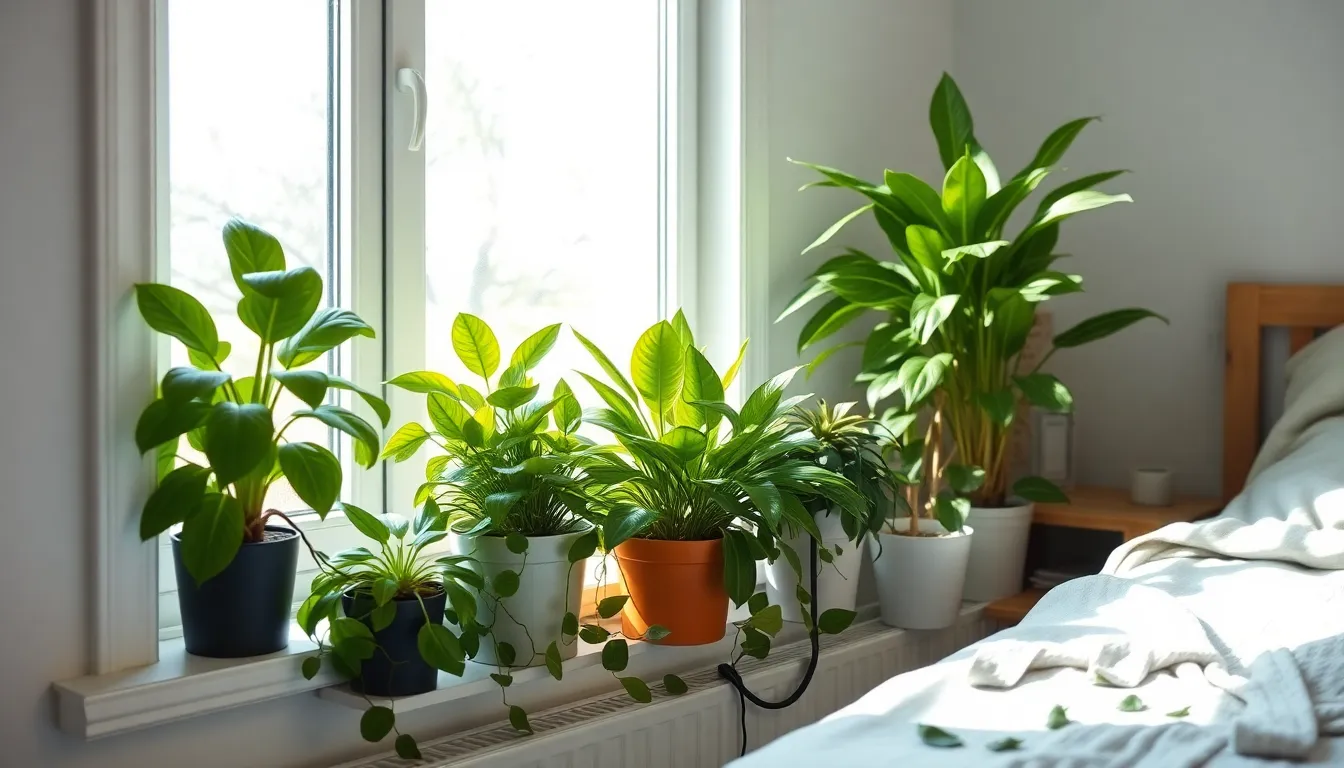
Keeping our bedroom plants healthy requires consistent attention to their basic needs. Proper care ensures they’ll continue purifying our air while maintaining their decorative appeal.
Watering Schedules for Indoor Plants
Check soil moisture weekly by testing the top inch with your finger. Golden Pothos and Lemon Lime Philodendron thrive when we water them weekly, allowing the soil to dry between waterings to prevent root rot.
Adjust frequency based on plant type since different species have varying water needs. Succulents and cacti positioned in sunny windowsills need watering less often due to their natural drought tolerance.
Maintain consistency to avoid shocking your plants with irregular care patterns. Overwatering causes more damage than underwatering, so we should never let plants sit in soggy soil.
Monitor seasonal changes as plants typically need less water during winter months when growth slows down. We’ll notice our plants using water more slowly in cooler temperatures and shorter daylight hours.
Lighting Answers for Plant Health
Position plants near windows to provide the bright, indirect light that most bedroom plants prefer. East or west facing windows offer moderate light levels perfect for species like pothos and philodendrons.
Choose low light tolerant varieties for bedrooms with limited natural light access. Snake plants (Sansevieria) and ZZ plants (Zamioculcas zamiifolia) flourish in dim conditions while still contributing to our bedroom’s aesthetic.
Use south facing windows for sun loving species that can handle more intense light throughout the day. We can place these brighter light plants further from north facing windows where light levels stay consistently lower.
Rotate plants regularly to ensure all sides receive equal light exposure and maintain balanced growth. Quarter turns every few weeks prevent our plants from leaning toward their light source.
Temperature Considerations for Bedroom Plants
Maintain temperatures between 60°F and 75°F since most common bedroom plants thrive in ranges that align perfectly with our comfortable sleeping temperatures. This natural overlap makes bedrooms ideal plant environments.
Avoid placement near vents where heating or cooling systems create sudden temperature fluctuations that stress plants. We should position our green companions away from direct airflow from HVAC systems.
Monitor humidity levels between 40% and 50% to help moisture loving plants like Lemon Lime Philodendron flourish in our bedroom environment. Grouping plants together naturally increases local humidity through transpiration.
Watch for temperature stress signs including leaf drop, wilting, or color changes that indicate our plants aren’t comfortable in their current location. Moving them to more stable temperature zones often resolves these issues quickly.
Avoid Common Mistakes When Decorating Bedrooms with Plants
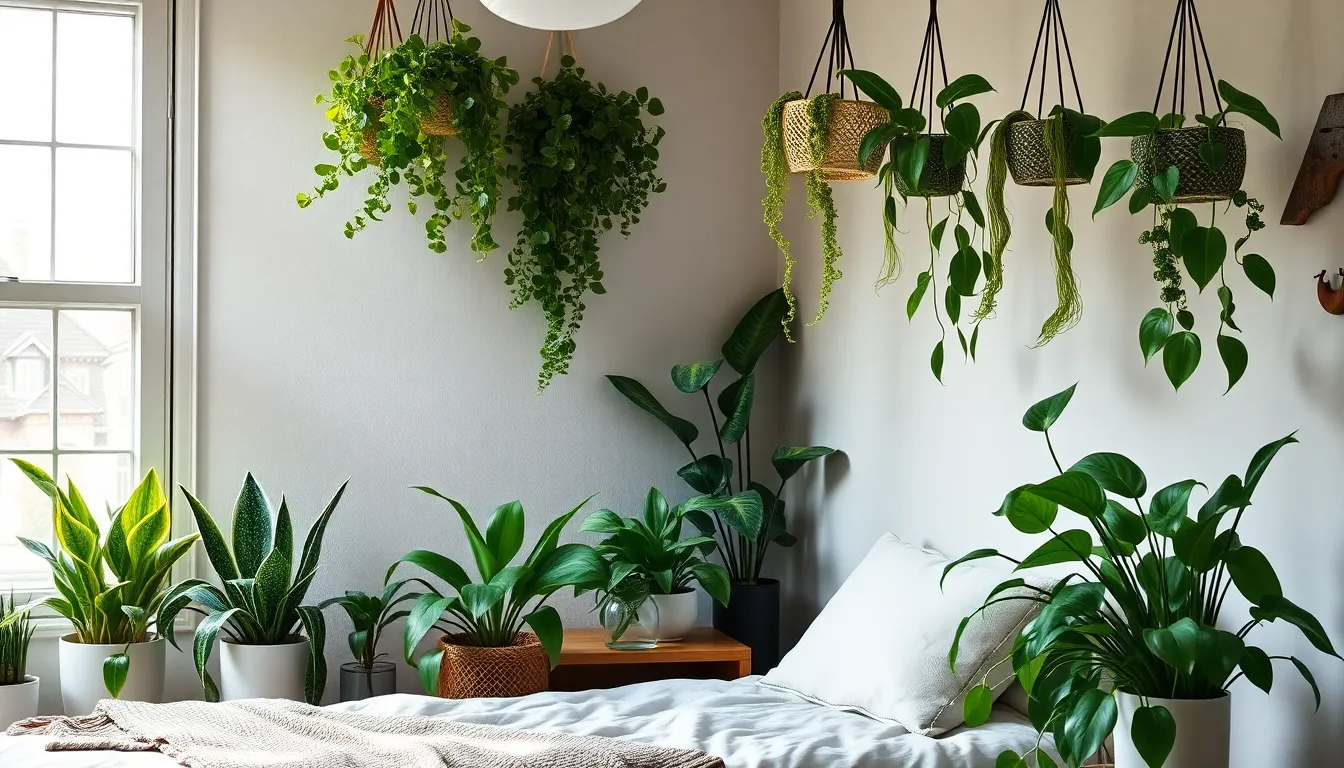
Even the most well-intentioned plant enthusiasts can make costly errors when creating their bedroom oasis. Learning from these common pitfalls will help you create a thriving indoor garden that enhances rather than hinders your sleep quality.
Overwatering Issues and Prevention
Overwatering kills more bedroom plants than any other factor. We often assume plants need frequent watering, but most bedroom varieties actually prefer to dry out between waterings. Snake plants and ZZ plants thrive with minimal water, requiring watering only every 2-3 weeks depending on your home’s humidity levels.
Prevention starts with proper drainage systems. Always choose pots with drainage holes to prevent waterlogging, which can lead to root rot and fungal growth. We recommend checking soil moisture by inserting your finger 1-2 inches deep into the soil – if it feels dry, then it’s time to water.
Monitor your watering schedule based on seasonal changes. Plants require less water during winter months when growth slows down, while summer heat may increase their water needs slightly. Establishing a consistent routine prevents the shock that comes from irregular watering patterns.
Choosing Wrong Plants for Bedroom Conditions
Selecting sun-loving plants for low-light bedrooms sets you up for failure. Many people choose beautiful plants they’ve seen in bright spaces without considering their bedroom’s lighting conditions. Snake plants, ZZ plants, and corn plants adapt exceptionally well to the dim environments typical of most bedrooms.
High-maintenance plants create unnecessary stress in sleeping spaces. We suggest avoiding plants that require daily attention, frequent repotting, or exact humidity requirements. Instead, focus on low-maintenance options that tolerate neglect and still provide air-purifying benefits.
Night oxygen production matters for bedroom plant selection. Choose plants like snake plants and aloe vera that continue releasing oxygen after dark, unlike most plants that switch to consuming oxygen at night. These species actively improve your sleep environment rather than competing for the oxygen you breathe.
Placement Errors That Affect Sleep Quality
Cluttered plant arrangements disrupt the peaceful atmosphere bedrooms require. We see many people cramming multiple plants onto nightstands or windowsills, creating visual chaos instead of serenity. Strategic placement on bedside tables, windowsills, or hanging in corners provides visual interest without overwhelming your sleeping space.
Large plants blocking pathways create unnecessary disturbance during nighttime movements. Avoid positioning floor plants directly between your door and bed, which can cause accidents during middle-of-the-night trips to the bathroom. Corner placement allows dramatic statement pieces like corn plants to add height and visual interest safely.
Plants should enhance relaxation rather than demand constant attention. Position your green companions where you can see them from bed to encourage tranquility, but not so prominently that dying leaves or drooping stems become sources of stress. Wall-mounted planters and hanging arrangements maximize visual impact while keeping floor space clear for peaceful movement.
Conclusion
We’ve shown you how plants can completely transform your bedroom into a peaceful sanctuary that’s both beautiful and beneficial for your health. From selecting the right low-light varieties to choosing containers that match your style these green additions offer endless possibilities for creating your perfect sleep space.
The key to success lies in understanding your room’s conditions and choosing plants that’ll thrive there. Whether you’re drawn to minimalist snake plants or lush tropical arrangements there’s a perfect combination waiting for you.
Remember that caring for bedroom plants doesn’t have to be complicated. With the right plant choices and simple maintenance routines you’ll enjoy cleaner air better sleep and a more inviting atmosphere every single night.
Frequently Asked Questions
What are the best plants for bedrooms with low light?
Snake plants, pothos, and ZZ plants are ideal for low-light bedrooms. Snake plants require minimal maintenance and produce oxygen at night, while pothos create beautiful cascading displays. ZZ plants thrive in dark corners and brighten small spaces. These plants adapt well to dim conditions and are perfect for bedrooms with limited natural light.
How do bedroom plants improve sleep quality?
Bedroom plants enhance sleep quality by purifying air and releasing fresh oxygen. Snake plants and English ivy continue producing oxygen at night, while spider plants filter toxins like formaldehyde and xylene. Bird’s nest ferns regulate humidity levels, creating optimal sleeping conditions. These benefits contribute to cleaner air and better rest.
What containers work best for bedroom plant displays?
Three container styles work excellently: ceramic pots for modern aesthetics, woven baskets for bohemian vibes, and hanging planters for vertical space. Choose containers that match your bedroom’s style while providing proper drainage. Sleek pots complement minimalist decor, while natural materials enhance Scandinavian themes.
Where should I place plants in my bedroom for maximum impact?
Place small plants on nightstands for a calming atmosphere, use corners for dramatic floor plants like corn plants, and consider wall-mounted planters for vertical interest. Strategic placement near windows provides optimal light, while statement plants in corners add height and visual appeal without cluttering the space.
How often should I water bedroom plants?
Watering frequency depends on plant type and season. Most bedroom plants need watering when the top inch of soil feels dry. Snake plants and ZZ plants require less frequent watering, while ferns need consistent moisture. Check soil regularly and adjust watering based on seasonal changes and humidity levels.
What common mistakes should I avoid with bedroom plants?
Avoid overwatering, which is the most common mistake leading to root rot. Don’t choose high-maintenance plants for low-light bedrooms, and avoid cluttered arrangements that disrupt peaceful atmospheres. Ensure proper drainage, monitor soil moisture, and select plants suited to your bedroom’s lighting conditions for best results.
Can I use artificial plants in my bedroom?
Yes, artificial plants work well in bedrooms with limited natural light or for those wanting low-maintenance alternatives. They’re perfect for wall-mounted displays and plant walls, creating living art pieces without care requirements. Choose high-quality artificial plants that complement your decor while providing visual benefits without maintenance concerns.
How do I style plants for different bedroom themes?
For minimalist bedrooms, use statement plants like snake plants in sleek pots with sparse arrangements. Scandinavian themes benefit from ferns and small palms in natural materials. Tropical-themed bedrooms should feature lush plants like areca palms and fiddle leaf figs in colorful containers for vibrant jungle atmospheres.

